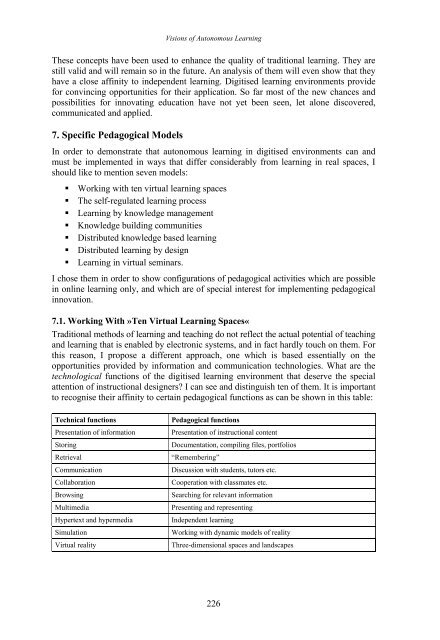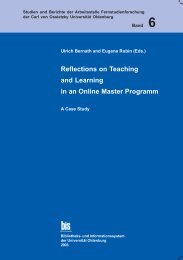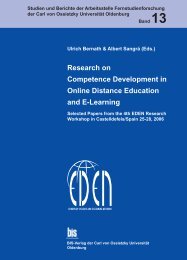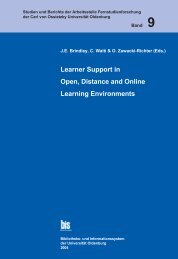Distance Education in Transition - Master of Distance Education ...
Distance Education in Transition - Master of Distance Education ...
Distance Education in Transition - Master of Distance Education ...
Create successful ePaper yourself
Turn your PDF publications into a flip-book with our unique Google optimized e-Paper software.
Visions <strong>of</strong> Autonomous Learn<strong>in</strong>g<br />
These concepts have been used to enhance the quality <strong>of</strong> traditional learn<strong>in</strong>g. They are<br />
still valid and will rema<strong>in</strong> so <strong>in</strong> the future. An analysis <strong>of</strong> them will even show that they<br />
have a close aff<strong>in</strong>ity to <strong>in</strong>dependent learn<strong>in</strong>g. Digitised learn<strong>in</strong>g environments provide<br />
for conv<strong>in</strong>c<strong>in</strong>g opportunities for their application. So far most <strong>of</strong> the new chances and<br />
possibilities for <strong>in</strong>novat<strong>in</strong>g education have not yet been seen, let alone discovered,<br />
communicated and applied.<br />
7. Specific Pedagogical Models<br />
In order to demonstrate that autonomous learn<strong>in</strong>g <strong>in</strong> digitised environments can and<br />
must be implemented <strong>in</strong> ways that differ considerably from learn<strong>in</strong>g <strong>in</strong> real spaces, I<br />
should like to mention seven models:<br />
� Work<strong>in</strong>g with ten virtual learn<strong>in</strong>g spaces<br />
� The self-regulated learn<strong>in</strong>g process<br />
� Learn<strong>in</strong>g by knowledge management<br />
� Knowledge build<strong>in</strong>g communities<br />
� Distributed knowledge based learn<strong>in</strong>g<br />
� Distributed learn<strong>in</strong>g by design<br />
� Learn<strong>in</strong>g <strong>in</strong> virtual sem<strong>in</strong>ars.<br />
I chose them <strong>in</strong> order to show configurations <strong>of</strong> pedagogical activities which are possible<br />
<strong>in</strong> onl<strong>in</strong>e learn<strong>in</strong>g only, and which are <strong>of</strong> special <strong>in</strong>terest for implement<strong>in</strong>g pedagogical<br />
<strong>in</strong>novation.<br />
7.1. Work<strong>in</strong>g With »Ten Virtual Learn<strong>in</strong>g Spaces«<br />
Traditional methods <strong>of</strong> learn<strong>in</strong>g and teach<strong>in</strong>g do not reflect the actual potential <strong>of</strong> teach<strong>in</strong>g<br />
and learn<strong>in</strong>g that is enabled by electronic systems, and <strong>in</strong> fact hardly touch on them. For<br />
this reason, I propose a different approach, one which is based essentially on the<br />
opportunities provided by <strong>in</strong>formation and communication technologies. What are the<br />
technological functions <strong>of</strong> the digitised learn<strong>in</strong>g environment that deserve the special<br />
attention <strong>of</strong> <strong>in</strong>structional designers? I can see and dist<strong>in</strong>guish ten <strong>of</strong> them. It is important<br />
to recognise their aff<strong>in</strong>ity to certa<strong>in</strong> pedagogical functions as can be shown <strong>in</strong> this table:<br />
Technical functions Pedagogical functions<br />
Presentation <strong>of</strong> <strong>in</strong>formation Presentation <strong>of</strong> <strong>in</strong>structional content<br />
Stor<strong>in</strong>g Documentation, compil<strong>in</strong>g files, portfolios<br />
Retrieval “Remember<strong>in</strong>g”<br />
Communication Discussion with students, tutors etc.<br />
Collaboration Cooperation with classmates etc.<br />
Brows<strong>in</strong>g Search<strong>in</strong>g for relevant <strong>in</strong>formation<br />
Multimedia Present<strong>in</strong>g and represent<strong>in</strong>g<br />
Hypertext and hypermedia Independent learn<strong>in</strong>g<br />
Simulation Work<strong>in</strong>g with dynamic models <strong>of</strong> reality<br />
Virtual reality Three-dimensional spaces and landscapes<br />
226





